Suzuki Grand Vitara: Brakes
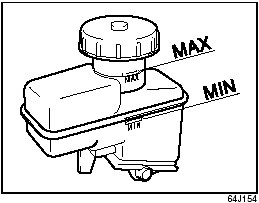
Brake Fluid
Check the brake fluid level by looking at the reservoir in the engine compartment. Check that the fluid level is between the “MAX” and “MIN” lines. If the brake fluid level is near the “MIN” line, fill it up to the “MAX” line with DOT3 brake fluid.
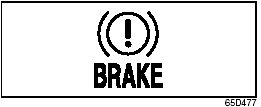
 WARNING: Failure to follow the
guidelines below can result in personal injury or serious damage to the brake system.
WARNING: Failure to follow the
guidelines below can result in personal injury or serious damage to the brake system.
• If the brake fluid in the reservoir drops below a certain level, the brake warning
light on the instrument panel will come on (the engine must be running with the
parking brake fully disengaged.) Should the light come on, immediately ask your
SUZUKI dealer to inspect the brake system.
• A rapid fluid loss indicates a leak in the brake system which should be inspected
by your SUZUKI dealer immediately.
• Brake fluid can harm your eyes and damage painted surfaces. Use caution when refilling
the reservoir.
• Do not use any fluid other than DOT3 brake fluid. Do not use reclaimed fluid or
fluid that has been stored in old or open containers. It is essential that foreign
particles and other liquids are kept out of the brake fluid reservoir.
 WARNING: Brake fluid is harmful
or fatal if swallowed, and harmful if it comes in contact with skin or eyes. If
swallowed, do not induce vomiting. Immediately contact a poison control center or
a physician. If brake fluid gets in eyes, flush eyes with water and seek medical
attention. Wash thoroughly after handling. Solution can be poisonous to animals.
Keep out of the reach of children and animals.
WARNING: Brake fluid is harmful
or fatal if swallowed, and harmful if it comes in contact with skin or eyes. If
swallowed, do not induce vomiting. Immediately contact a poison control center or
a physician. If brake fluid gets in eyes, flush eyes with water and seek medical
attention. Wash thoroughly after handling. Solution can be poisonous to animals.
Keep out of the reach of children and animals.
CAUTION: The brake fluid should be replaced according to the maintenance schedule. Have the brake fluid replaced by your SUZUKI dealer.
NOTE: With disc brakes, the fluid level can be expected to gradually fall as the brake pads wear.
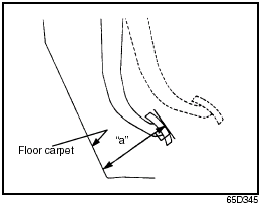
Brake Pedal

With the engine running and the parking brake set, measure the distance between the brake pedal and floor carpet when the pedal is depressed with approximately 300 N (66 lbs, 30 kg) of force. The minimum distance required is as specified. Since your vehicle’s brake system is self-adjusting, there is no need for pedal adjustment. If the pedal to floor carpet distance as measured above is less than the minimum distance required, have your vehicle inspected by your SUZUKI dealer.
NOTE: When measuring the distance between the brake pedal and floor wall, push in the floor carpet as far as it goes and measure the distance between the carpet surface and the brake pedal.
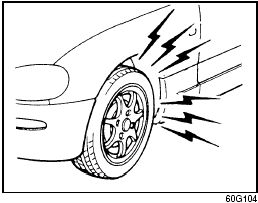
 WARNING: If you experience any
of the following problems with your vehicle’s brake system, have the vehicle inspected
immediately by your SUZUKI dealer.
WARNING: If you experience any
of the following problems with your vehicle’s brake system, have the vehicle inspected
immediately by your SUZUKI dealer.
• Poor braking performance.
• Uneven braking (Brakes not working uniformly on all wheels.).
• Excessive pedal travel.
• Brake dragging.
• Excessive noise.
• (Except ABS equipped vehicle). Pedal pulsation (Pedal pulsates when pressed for
braking.)
Parking Brake Lever
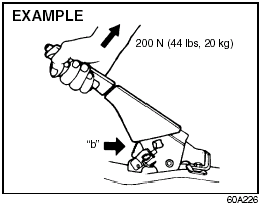
Parking Brake
Lever

Check the parking brake for proper adjustment by counting the number of clicks made by the ratchet teeth as you slowly pull up on the parking brake lever to the point of full engagement. The parking brake lever should stop between the specified ratchet teeth and the rear wheels should be securely locked. If the parking brake is not properly adjusted or the brakes drag after the lever has been fully released, have the parking brake inspected and/or adjusted by your SUZUKI dealer.
Steering Wheel

Steering Wheel

Check the play of the steering wheel by gently turning it from left to right and measuring the distance that it moves before you feel slight resistance. The play should be between the specified values. Check that the steering wheel turns easily and smoothly without rattling by turning it all the way to the right and to the left while driving very slowly in an open area. If the amount of free play is outside the specification or you find anything else to be wrong, an inspection must be performed by your SUZUKI dealer.
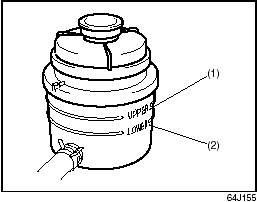
Power Steering
(if equipped) (1) UPPER (2) LOWER
Check the steering box case, vane pump and hose connections for leaks or damage.
Power Steering Fluid
Check the fluid level by looking at the reservoir in the engine compartment when the fluid is cold (about room temperature). Check that the fluid level is between the (1) and (2) lines. If the fluid level is near the (2) line, fill it up to the (1) line with an automatic transmission fluid equivalent to ATF DEXRON®-II (Esso JWS 2326) or DEXRON®-III. Do not overfill.
Clutch Pedal

Clutch Pedal
Check the clutch pedal for smooth operation and clutch fluid level from time to time. If clutch dragging is felt with the pedal fully depressed, have the clutch inspected by your SUZUKI dealer. If the clutch fluid level is near the “MIN” line, fill it up to the “MAX” line with DOT3 brake fluid.
See also:
Front seats
- Never adjust the seat while driving
to avoid the possibility of
loss of vehicle control and of
personal injury.
- Before adjusting the seat, make
sure the hands and feet of rear
seat passengers and cargo are
clear of the adjusting ...
Hands-free Bluetooth® cellular phone interface system with voice recognition*
The Hands-free Bluetooth® cellular phone interface system with voice recognition
uses a wireless communication technology known as Bluetooth® to allow you to make
hands-free calls in your vehicle using your Bluetooth® compatible cellular phone ...

 Engine Coolant
Engine Coolant